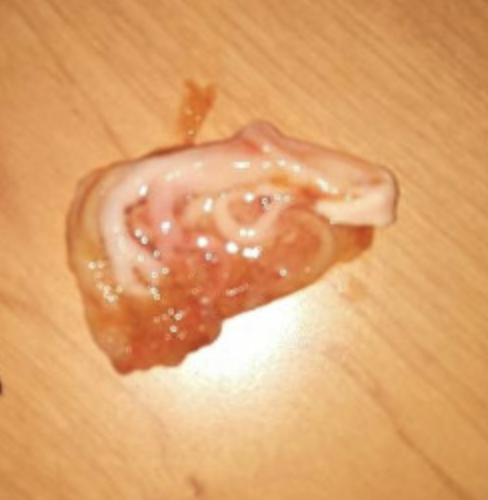Case Presentation: A 54-year-old male with a history of obesity, asthma, alcohol use disorder, tobacco use disorder, and hepatic steatosis presented with anasarca. Transthoracic echocardiogram did not demonstrate evidence of heart failure, urinalysis revealed trace proteinuria, and liver ultrasound showed patent vasculature. Albumin was 2.5. The anasarca persisted despite diuresis. Over the next two months, he was hospitalized twice for new onset dyspnea and productive cough thought to be due to heart failure exacerbation and pneumonia. Empiric antibiotics, steroids, and diuresis minimally improved his symptoms. He was re-hospitalized for severe hypoxemic respiratory failure requiring non-invasive positive pressure ventilation. CT scan of the chest showed bilateral, patchy ground-glass opacities and endobronchial secretions. Microbial studies, autoimmune serologies, and lung biopsy did not reveal an etiology. He was treated with bronchopulmonary hygiene and airway clearance therapies and began to expectorate large bronchial casts. Lymphangiogram revealed a left thoracic duct leak. A large cast was removed during bronchoscopy, and histopathology was consistent with lymph, confirming the diagnosis of plastic bronchitis. His symptoms improved initially but worsened within days. Repeat CT scan showed an organizing pneumonia pattern of lung injury of unclear etiology. Lymphangiogram was repeated, and the thoracic duct was embolized. Without evidence of infection, he was empirically treated with corticosteroids. His clinical status improved, and he was discharged on oxygen and continued airway clearance therapies with plan for follow-up with interventional radiology for possible repeat embolization.
Discussion: Plastic bronchitis is a rare condition in adults that can be life-threatening. Patients classically present with respiratory failure and expectoration of gelatinous casts in the shape of branching airways. The pathophysiology of this disorder remains unclear, but many cases are linked to lymphatic abnormalities that contribute to chyle leakage into the airways [1]. The etiology is heterogeneous and may be congenital, traumatic, infectious, or idiopathic [2]. Although not previously reported, a chyle leak could also contribute to anasarca without a clear alternative etiology, as chyle is rich in albumin. Diagnosing plastic bronchitis can be challenging, leading to delays in appropriate treatment, extended hospital stays, and multiple procedures. Casts should be obtained for pathologic analysis, and the presence of mucinous, fibrous, or chylous casts confirms the diagnosis [1]. Treatment involves supportive respiratory care and intermittent bronchoscopic extraction of casts. If available, lymphangiogram with selective embolization can be curative [2].
Conclusions: Abnormalities of the lymphatic system are a rare but important cause of hypoxemic respiratory failure and should be considered in patients with unexplained hypoxemia and productive cough, when empiric treatments for more common diagnoses have failed. Expectoration of bronchial casts warrant supportive care and specialized workup with advanced imaging, such as lymphangiogram, and consideration of surgical intervention.

